The Full Kawah Ijen Guide + Rules and Regulations in 2024
Kawah Ijen is an extraordinary place in Java, Indonesia in the entire world! The Mount Ijen Crater houses the largest acidic lake in the world!
Moreover, it’s one of the very few places in the world where you can see the fabled Blue Fire. Don’t get me started about the awesome sunrise at the crater rim above!
In this Kawah Ijen guide, I will tell you everything you need to know to visit this marvelous volcano, the current regulations, and the practical details.
On 12 July 2024, authorities increased the Alert Level for Kawah Ijen to Level II and all human activity has been temporarily suspended within 1.5 km of the crater rim until further notice (source). This is due to increased volcanic activity and is not expected to continue for long.
Until this is reversed, hiking Kawah Ijen is not possible.
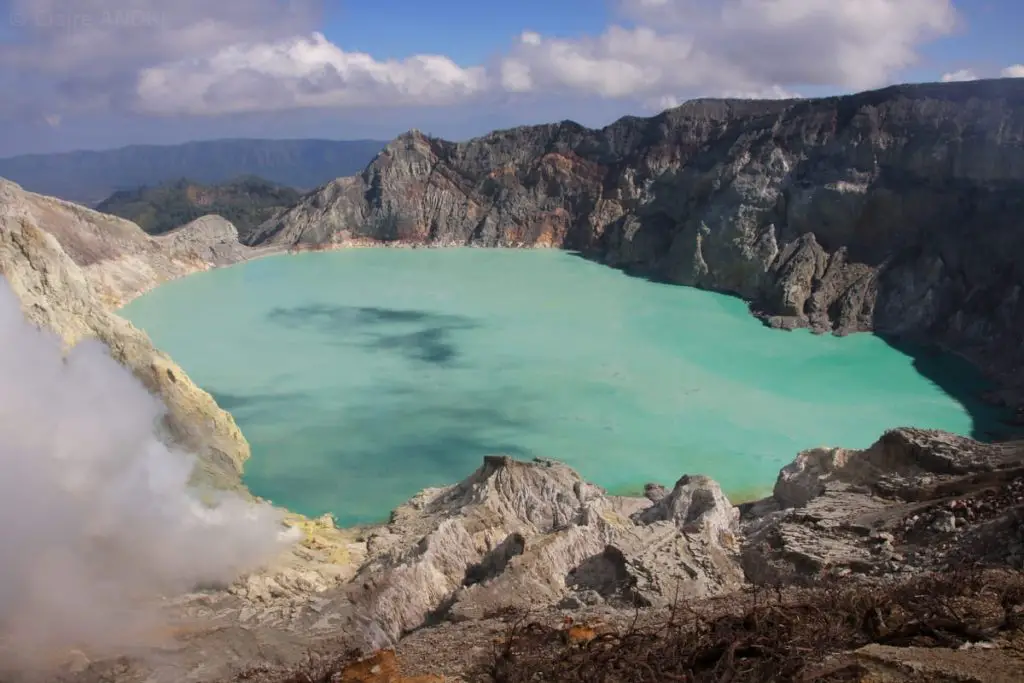
Kawah Ijen is part of my complete 14-day Java Backpacking Itinerary.
Kawah Ijen Requirements & Regulations
The requirements for Kawah Ijen change quite often. It was closed during the pandemic, then for a long time in 2023, visitors could only enter at 4 AM (too late to see the blue fire) and after this was pulled back to 2 AM going down the crater was officially forbidden (but only officially).
Since 6 January 2024, it’s now compulsory that all visitors to Kawah Ijen have a medical certificate and be accompanied by a guide. You must also book your ticket online before going.
Here are all the official requirements:
- Medical Certificate
- A local guide
- Personal protective equipment (appropriate shoes and clothes and a gas mask provided at the entrance)
- Ticket reservations must be done online here
- No refunds for tickets on the day of the ascend
Insurance is NOT mandatory but strongly recommended and the authorities accept no responsibility for any incidents.
This was strongly worded because of the recent death of a 64-year-old Indonesian tourist during the hike. He wasn’t even hiking but using the trolley taxis, however, he felt weak, out of breath and the oxygen he was given wasn’t enough to save him.
Even more recently, a Polish tourist was found dead on the slopes.
Then in April 2024, a Chinese tourist disregarded the caution notices and the warnings not to go further than allowed, then fell into the crater while taking a photo.
Kawah Ijen is no joke if you’re in bad health or careless.
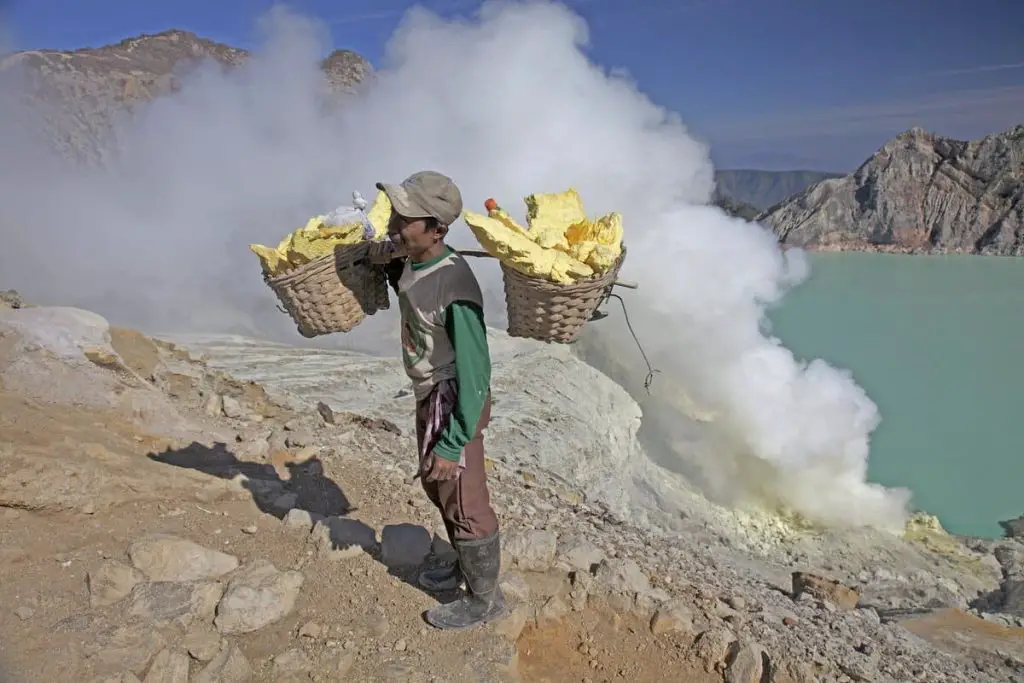
Medical Certificate
If you wish to visit Kawah Ijen you must have a medical certificate showing you are in a good physical and mental condition.
In practice, this means you must visit a hospital or a clinic before climbing. Here are your options in Banyuwangi, the closest city:
- Klinik Shinta (cheapest at 40.000 IDR / 2.5$)
- Yasmin Hospital
- Puskesmas Mojopanggung
- Klinik Brawijaya
- Klinik Prambanan
Reportedly, there is also a pop-up clinic at the entrance of Kawah Ijen. I wouldn’t rely on it – it probably costs extra and there may be queues. Do let me know in the comments if you’ve visited recently.
The medical certificate costs between 40.000 and 100.000 IDR (2.5-6.5$) and takes about an hour to get.
It’s not just for show either – there are certain health requirements you must meet to be issued a medical certificate.
You cannot hike Kawah Ijen if you:
- Have heart problems
- Have asthma
- Weigh more than 100 kg
- Are pregnant
- Are under 3 years old (for the parents among you – don’t bring your baby to a volcano)
The certificate is issued immediately at the hospital or clinic if you successfully pass the health examination and after you pay.
Is a guide mandatory?
Yes, after January 6, 2024, anyone wishing to visit Kawah Ijen must be accompanied by a licensed guide.
This is easy to comply with if you go on a tour. They include a guide, transport to and from, and a gas mask. Some have started facilitating medical certificates too.
Take a look at one of these depending on your circumstances:
- Kawah Ijen from Banyuwangi (budget option, includes the medical check)
- Kawah Ijen from Bali (convenient if staying anywhere in Bali)
- Kawah Ijen combined with Bromo from Bali (3-day super tour of Java’s most popular volcanoes)
- Kawah Ijen + Bromo from Malang (2-day tour with an option to continue to Bali)
Go to Ijen independently and get a guide at the entrance
If you turn up at the entrance of Kawah Ijen, say after driving a motorcycle to get there, you can still find a way to enter. Numerous local guides sit at the entrance ready to be hired for the day.
Negotiate a price with them and you’ll be allowed to enter. Your guide may or may not actually be licensed, but nobody really cares.
Kawah Ijen Opening Times
In 2024, Kawah Ijen gates open at 2:00 AM. It takes at least 90 minutes to reach the summit. At this time it will still be quite dark, thus possible to observe the Blue Fire.
Kawah Ijen remains open until 12:00 at noon.
Kawah Ijen is closed on the first Friday of every month for conservation.
Going down the crater
Going down the crater is officially forbidden.
But that’s only officially. Organized tours regularly disregard this ban and bring people inside the crater against the official rules.
Now that everybody is required to have a guide with them, mark my words that everyone will go down the crater. As counterintuitive as this seems, that’s how the tourism industry at Kawah Ijen has always operated.
If you want to absolutely guarantee that you will see the blue fire, book this Kawah Ijen Blue Fire Tour.
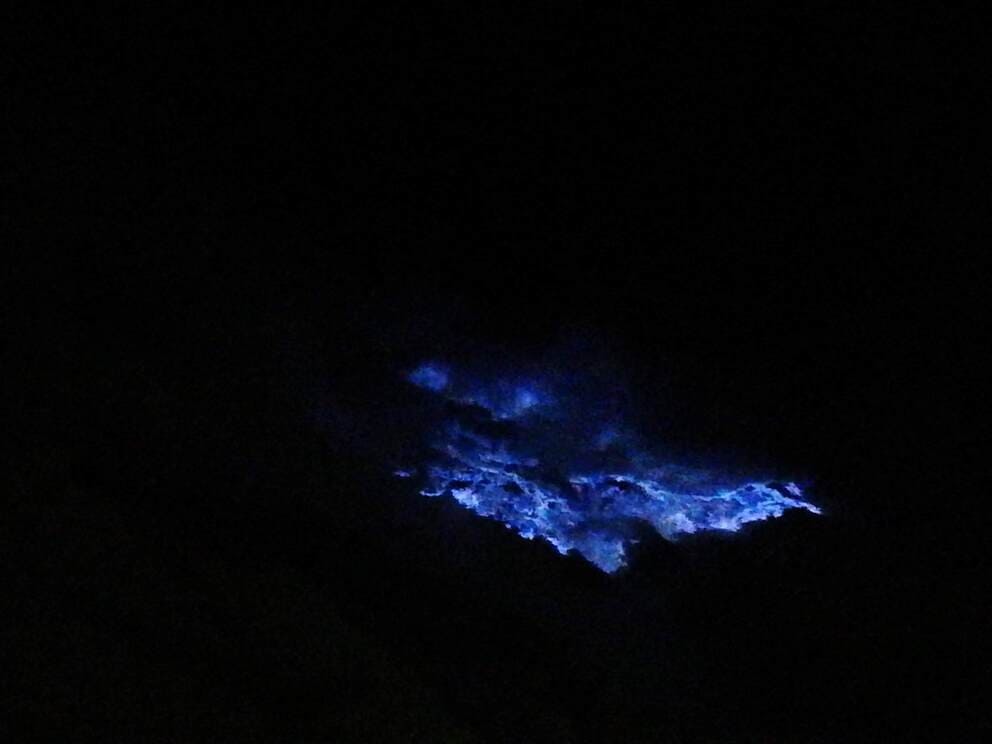
Entrance Fee
The entrance fee to Kawah Ijen (foreigners) is 100.000 IDR (6.6$) on a weekday and 150.000 IDR (10$) on the weekend. Local Indonesian tourists pay 5.000 or 7.500 IDR respectively.
Parking costs 5.000 IDR for a scooter and 10.000 IDR for a car.
Online Ticket Reservation
You MUST reserve your ticket online before going to Kawah Ijen.
I’ve heard of multiple travelers turned back at the entrance because they didn’t reserve a ticket.
Reservations are made online on the Ijen Blue Fire web portal. Payment is made on the spot at Kawah Ijen.
Online payment options are only possible for local Indonesian tourists with access to local digital payment solutions. Read more about money in Indonesia.
How to get to Kawah Ijen from Bali
There are very affordable public transport options from Bali to Banyuwangi, a popular base for a hike to Mount Ijen.
Bali to Ijen Crater by bus
There are frequent buses between the port city of Gilimanuk and destinations in Bali. The most common are Lovina and Denpasar.
- From Denpasar to Gilimanuk the public buses depart from Ubung Bus Terminal at 8:00 every day. The ticket costs 50.000 IDR / 3.4$; Luxury AC buses are also available.
- From Lovina to Gilimanuk the public minibuses (bemos) pass by the main road. It costs 30.000 IDR (2$) although locals will try to convince you to pay them 100.000 IDR so that they stop it for you. It’s a trap!
- At Gilimanuk, board the ferry and cross over to Ketapang. The ferry costs 6500 IDR / 0.45$ and runs every 20-25 mins, 24/7.
- From Ketapang take a train, bus, or Grab taxi to Banyuwangi depending on timetable and availability.
It is possible to travel on your own motorcycle from Bali to Java. Getting a rented motorcycle across the Bali Strait is allowed and you don’t need any additional documents.

Probolinggo to Kawah Ijen by train
The cheapest and most convenient way to travel between Probolinggo and Banyuwangi is by train.
Why Probolinggo? Because it’s the closest city to Mount Bromo. Here’s how to visit Mount Bromo on a budget from Probolinggo.
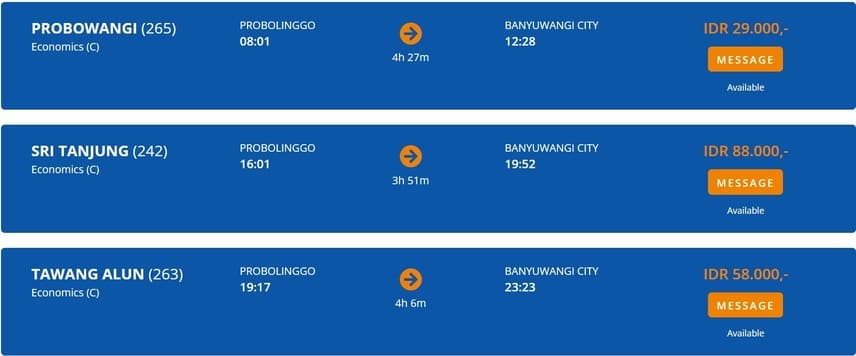
If you’re traveling to Banyuwangi from Surabaya or Malang, it’s more or less the same trains except for the Probowangi train. Check and book train tickets online on Kai Access.
You can travel from Yogyakarta all the way to Ketapang Harbor on your way to Bali by the same trains. Check out my full review of the travel options between Yogyakarta and Bali.
Banyuwangi to Kawah Ijen Entrance
This leg of the journey also really depends on whether or not you want to climb Kawah Ijen as early as possible for the sunrise.
Kawah Ijen opens at 2:00, although some groups are let in at 1:45.
Sunrise at Kawah Ijen is between 5:28 and 6:07 depending on the month.
Damri Bus
There used to be a public DAMRI bus from Banyuwangi to Kawah Ijen, which has been discontinued since 2021. Surprisingly, neighboring Jember restarted its public bus to Kawah Ijen in early 2024. But Banyuwangi hasn’t.
Motorcycle or Taxi
The only way to independently go to Mount Ijen from Banyuwangi is by a rental motorcycle or a private transfer.
You can arrange both of those in person in Banyuwangi.
If you want absolutely no crowds at all, go to Ijen at 8:00 as everybody will have left by that time. You will have all of Ijen’s natural beauty for yourself. The drawback to this is that you won’t see the Blue Fire.
What to expect while hiking Kawah Ijen
Hiking to the top of Mount Ijen is relatively easy. It’s a little harder than hiking for the sunrise at Dieng Plateau and the sunrise at Bromo, but definitely much easier than Merbabu or Rinjani.
The hike is straightforward, well-trodden, and paved for the first 30 minutes. It takes around 90 minutes to hike to the top (~3.5 km with 450 meters altitude change).
Going down the crater is a little more difficult, especially with the crowds, and even harder when a tour guide tries to cut in front of everybody on the trail to bring his group down first.

For those too unfit to walk, locals offer a “taxi” service. You sit down in a small cart and 2-4 men carry you up like some spoilt king.
Some still take advantage of the incredible offer to pay 800.000 IDR (51$) to not walk a single step to the top.
The trail is marked on Maps.me. The way back is hard on the knees, but nothing extraordinary.
The Acidic Lake
In the middle of the Ijen crater is the notoriously acidic lake with a uniquely aquamarine color. The PH has been measured at less than 0.5 on the edges and down to 0.13 in the center.
The PH scale goes from 0 (extremely acidic) to 14 (extremely basic) with 7 being pure water. Every unit denotes 10 times more or less acidity (i.e. PH3 is 10 times more acidic than PH4)
For example, lemon juice has a PH between 2 and 3, so it’s between 10.000 and 100.000 times more acidic than water.
0.13 on the PH scale is so extremely acidic that it will cause burns on your skin. It cannot dissolve metals as quickly as in movies though.
All of this is to say: if you manage to get down inside the Ijen crater, don’t touch the lake.

The Sulfur Miners
On the hiking trail towards Kawah Ijen, you will see men lugging heavy loads of yellow stones on their shoulders. Sometimes it’s as heavy as 90 kg and the men are still quicker than most people on the trail. It’s truly remarkable.
Sulfur is mined 24/7. It takes the men around 2-3 hours to go up Kawah Ijen, down the crater, load some sulfur, then go back down and unload it. They get paid 1.000 IDR (0.07$) per kilogram.
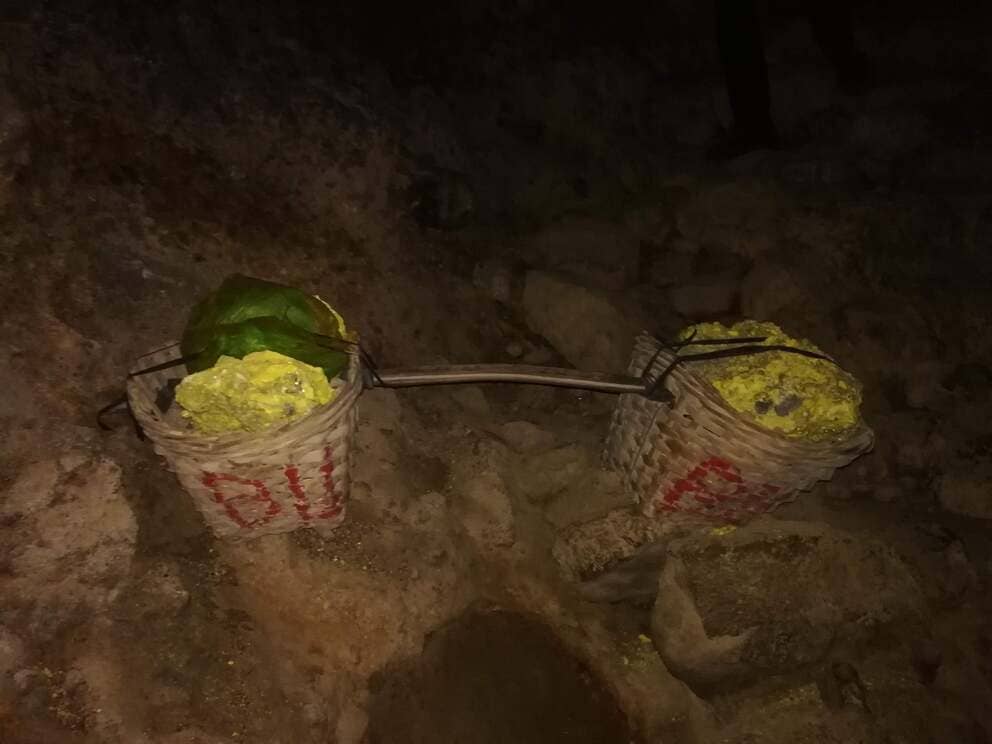
Miners do 2 or 3 such runs every day. It is hard work and I honestly have great appreciation for their endurance. This amounts to less than 15$ per day for this exhausting work.
If you want to support them, you have the chance to buy sulfur figurines all along the trail and at the summit.
Do you need a gas mask for Kawah Ijen?
You must have a gas mask with you while hiking Kawah Ijen.
Organized tours provide one but independent travelers can hire a gas mask at the entrance for 45.000 IDR (3$).
If you are going down the crater I strongly advise you to wear the gas mask. When I went to Kawah Ijen I saw the blue flame up close and personal and a gas mask was imperative. At a certain point, it barely blocked any of the sulfur anymore but I can’t imagine what it’d be like without one at all.
The sulfur smoke is strong down there and breathing EVEN WITH a gas mask is a challenge. I could barely open my eyes too.
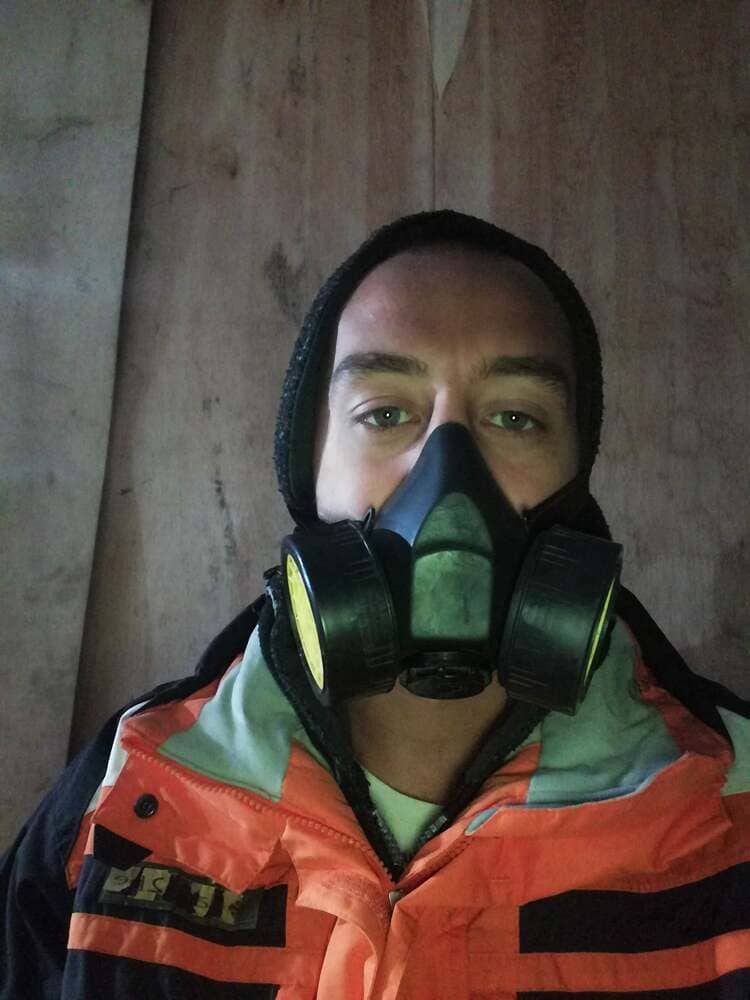
At the rim of the crater, you might feel a whiff of sulfur, but it’s just a slight smell of rotten eggs. You are still required to carry it but there’s no need for it. Unless you’re taking pictures for Instagram.
Food on the hike
There’s some food and drinks just before you start the hike and it’s a good idea to take a bite or two for some energy before you go.
On the hike itself, there’s one small cafe with pot noodles, coffee, and chocolate bars.
It’s always wise to carry some food like energy bars or a banana.
Carry some water too, of course.
What to wear
Remember that Kawah Ijen is high. The hike starts at 1860 m. and ends at 2700 m. Additionally, you will be there in the early morning when it’s coldest.
Dress up in layers. To begin the hike you’d need a winter jacket, warm sweater, long pants, closed shoes, and thick socks. A hat and gloves are also a good idea. Peel off layers as your body warms up during the hike.
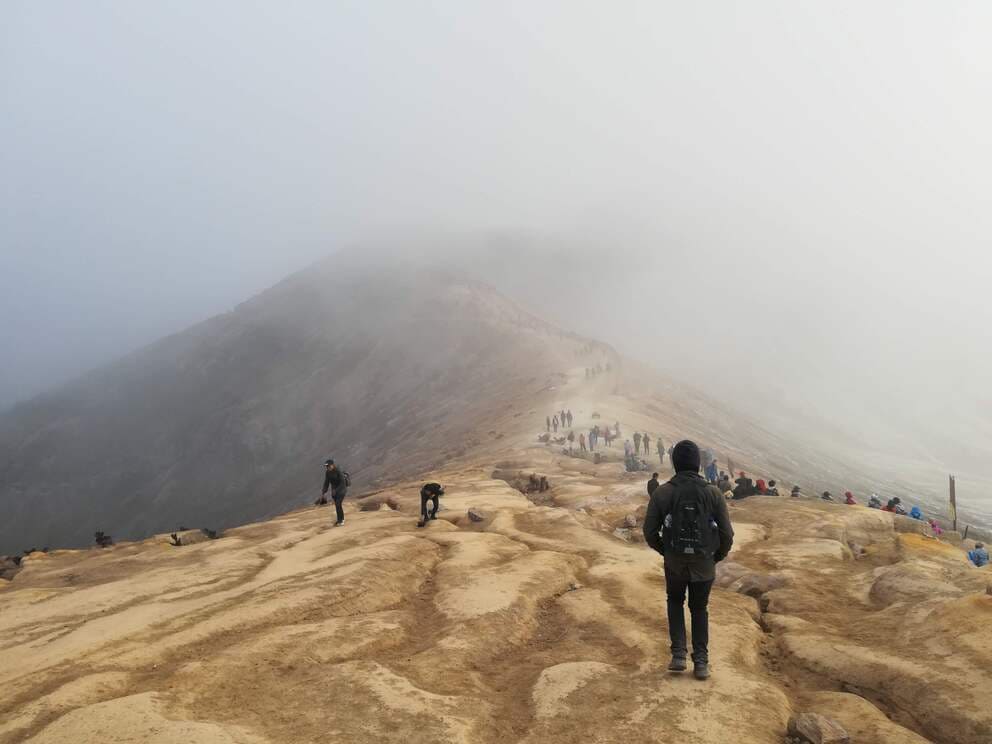
Where to stay near Kawah Ijen
Most backpackers stay in Banyuwangi. It’s a small uneventful town with extremely loud mosques and apart from being something of a base camp for Kawah Ijen, there’s not much else to it.
In Banyuwangi, my recommendation for backpackers goes to the Mango Tree Homestay. It’s cheap, clean, and conveniently located and the hosts are extremely helpful with all things Ijen.
If you want to stay even closer to Kawah Ijen, you can find cheap accommodation in Licin. I haven’t personally stayed there, but I have heard very good things about Nio Homestay.
You can organize a pickup with the host from the harbor or the train station as well as tours or just transport to Kawah Ijen.

Hi Simon, this is a fantastically detailed post, thank you so much! One question for clarification: I clicked on the link you provided for making reservations to hike Kawa Ijen, but I can’t seem to figure this out and it wants me to log in via my Google account (is this legit?). Is this really the offical website? https://tiket.bbksdajatim.org/ If so, how does one reserve tickets? Thanks for sharing your experiences.
Hi Simone,
Yes, the link is correct. And yes, I totally agree that it’s not the best user experience but neither are many things in Indonesia (the eVoA online portal comes to mind immediately).
Anyway, you have to log in with your google account (again, I agree this is unnecessary…). You can make the page in English with the button in the lower left. Then:
1) Click on “Ticket Order”
2) Click “Agree”
3) Choose “TWA Kawah Ijen”
4) Pick number of tickets. Foreigners should pick “WNA” with the corresonding price.
5) Also pick your vehicle. For some reason the system won’t let you proceed until you pick either car or motorcycle. This would mean you also have to pay 5/10k IDR for it. Click “Lanjut” (continue).
6) Enter your passport data
7) Click “Order”.
That’s it! The QR code with the ticket will be sent to your email address. Actual payment – at the gate upon arrival.
Nota Bene: Given that there are 2000 tickets daily, I suspect it will be alright even if you just turn up at Kawah Ijen entrance and do whatever procedure they ask you to do then and there. But when it comes to what’s officially required – that’s it.
Best,
Simon
Hello Simon,
You have written all the information that I was looking for. Incredibly useful.
Thank you so much 🙂